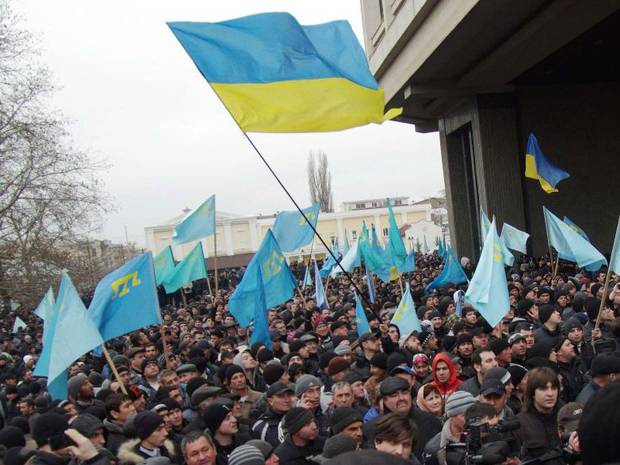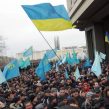
Rehabilitation of Crimean Tatars Could Reverberate in the North Caucasus
Publication: Eurasia Daily Monitor Volume: 11 Issue: 65
By:

On April 1, Russian President Vladimir Putin met in Moscow with Tatarstani President Rustam Minnikhanov, who informed Putin about his three recent visits to Crimea. Apparently acting as liaison between the Kremlin and the Crimean Tatars, Tatarstan’s president told Putin that the Crimean Tatar leaders would like to be rehabilitated on the basis of the Russian legislation on rehabilitation of repressed peoples passed back in 1991. Second, Tatar activists would like to meet Putin in person and, third, want the Tatars’ semi-legal settlements in Crimea fully legalized and their infrastructure upgraded, Minnikhanov said. Putin enthusiastically responded to these propositions, saying: “I will certainly entrust [my administration] to work on all these issues, all three” (https://www.kremlin.ru/news/20671).
The Crimean Tatars have shown the greatest hostility to Russia’s takeover of Crimea among the peninsula’s population. Relations between the Crimean Tatars and ethnic Russians there have been rocky since the Tatars were allowed back to their historic homeland in 1989 after more than 40 years in exile. Due to the high attention of the West and Ukraine to the Crimean crisis, the Russian authorities cannot simply brush aside the local population’s grievances. Instead, they are trying to appease the locals as much as they can. Feeling this, some Crimean Tatars are trying to use the opportunity to advance their goals while Russia is ready to listen to them. Just before the so-called referendum on March 16, Russian authorities promised to rehabilitate the Crimean Tatars, according to the existing Russian legislation. Over 180,000, Crimean Tatars were sent en masse into exile to Central Asia in 1944 for alleged collaboration with Germany during the Second World War (https://www.newsru.com/russia/14mar2014/mironov.html).
The revival of the 1991 law on the rehabilitation of repressed peoples, however, may open a new round of claims by other ethnic groups in the Russian Federation, especially in the North Caucasus. When the Crimean Tatars were deported to Central Asia in 1944, the Crimean peninsula was an administrative part of the Russian Soviet Federative Socialist Republic. By claiming historical rights to the peninsula, Moscow assumes its historical responsibilities. Well-known Russian expert Maksim Shevchenko told the RBC news agency: “The first aspect is moral—restoring historical justice. The second aspect is the issue of land. The [Crimean] Tatars started to return to their historical lands only after 1989. Naturally, all the land was taken and their houses were occupied by other people. So the Crimean Tatars were allotted the worst land and that is why the Crimean Tatars have harbored an acute sense of injustice. All the peoples of Crimea should be given back their rights” (https://rt.rbc.ru/tatarstan_topnews/01/04/2014/914837.shtml).
The problem for Moscow is that a number of other groups in Russia may require rehabilitation. Although quite a few ethnic groups were deported en masse to remote areas of Russia in the 20th century, the concentration of such cases was the highest in the North Caucasus. Joseph Stalin sent the Chechens, Ingush, Balkars and Karachays into exile to Central Asia in the 1940s. Although these groups were allowed to return to their historical homelands soon after Stalin’s death, territorial disputes with the neighbors still remained.
The Ingush and Ossetians fought a short, but bloody conflict over disputed land in North Ossetia in 1992 that cost hundreds of lives and resulted in tens of thousands of refugees. The Ossetian-Ingush conflict has never been resolved even though it was officially proclaimed “solved” several years ago. The Chechens are still trying to reclaim their pre-deportation land in the western part of Dagestan. The Karachays and Balkars, respectively, have conflicts with the Cherkess and the Kabardins over land and power in Karachaevo-Cherkessia and Kabardino-Balkaria. Moscow tried to pretend that the issue of rehabilitating groups that were sent into exile in the 1940s was resolved, but rehabilitating the Crimean Tatars is bound to remind affected ethnic groups among the North Caucasians of their own unresolved problems, including long-running territorial disputes. This is likely to contribute to increasing tensions in the region and the rise of nationalism.
As the Crimean Tatars try to extract as many benefits from Russia as possible (https://www.ntv.ru/novosti/874897/), Moscow is attempting to contain their ambitions within the limits of Russian Federation. The indigenous populations of the peninsula once again find themselves trapped inside another reiteration of the Russian Empire and they want to make sure that they will not be deported once again (https://kavpolit.com/articles/zvanye_tatarskie_gosti-2638/).
Even though Moscow has indicated it is amenable to Crimean Tatar demands now, this benevolence is likely to be only temporary. If the tensions around Crimea dissipate, the Crimean Tatars will feel the heat of being an ethnic minority in Russia and the Russian government’s lack of follow-through on its promises. The large Russian majority in Crimea is unlikely to tolerate overly expansive Crimean Tatar demands, so rising tensions on the peninsula are almost guaranteed as each community tries to gain as much as possible in this tumultuous period.




